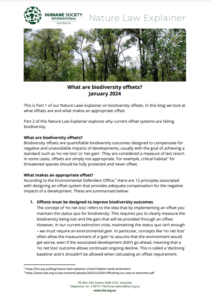You might remember Kalpana—I am happy to report that this year she celebrates her fifth rescue anniversary at Wildlife SOS. Formerly exploited and abused as a ‘begging’ elephant in Uttar Pradesh, Kalpana was rescued in 2019 and brought to the Wildlife SOS Elephant Hospital Campus (EHC) in Mathura for comprehensive...
This is Part 1 of our Nature Laws Explainer on biodiversity offsets. In this blog we look at what offsets are and what makes an appropriate offset.
Part 2 of this Nature Law Explainer explores why current offset systems are failing biodiversity.
What are biodiversity offsets?
Biodiversity offsets are quantifiable biodiversity outcomes designed to compensate for negative and unavoidable impacts of developments, usually with the goal of achieving a standard such as ‘no net loss’ or ‘net gain’. They are considered a measure of last resort. In some cases, offsets are simply not appropriate. For example, critical habitat for threatened species should be fully protected and never offset.
What makes an appropriate offset?
According to the Environmental Defenders Office, there are 12 principles associated with designing an offset system that provides adequate compensation for the negative impacts of a development. These are summarised below:
1) Offsets must be designed to improve biodiversity outcomes.
The concept of ‘no net loss’ refers to the idea that by implementing an offset you maintain the status quo for biodiversity. This requires you to clearly measure the biodiversity being lost and the gain that will be provided through an offset. However, in our current extinction crisis, maintaining the status quo isn’t enough – we must require an environmental gain. In particular, concepts like ‘no net loss’ often allow the measurement of a ‘gain’ to assume that the environment would get worse, even if the associated development didn’t go ahead, meaning that a ‘no net loss’ outcome allows continued ongoing decline. This is called a ‘declining baseline’ and it shouldn’t be allowed when calculating an offset requirement.
2) Biodiversity offsets must only be used as a last resort.
Instead of considering all options to avoid or minimise impacts, too often developers will go straight to calculating their offsets rather than reworking projects to avoid harm. This is because the cost of offsetting is often less than the cost of ecologically sustainable development. Developers must be required to take all possible steps to avoid and mitigate first.
3) Offsets must be based on genuine ‘like for like’ principles.
‘Like for like’ means that the thing being harmed must be the thing that is offset. For example, if you are going to harm koala habitat, you must create an offset that protects and enhances koala habitat close enough to the development that it will deliver a meaningful gain for the impacted koalas. Currently, ‘like for like’ is being used with too much flexibility so that instead of offsetting the impacted matter, such as a koala, you can create an offset for something that is more threatened, for example a frog. That might be good for the frog but it drives ongoing decline for koalas.
4) Legislation and policy must set clear limits on the use of offsets.
Some things are simply too precious to be offset, for example critical habitat. Any development proposing to impact on critical habitat, or create any other unacceptable impact, must be refused.
5) Time lags in securing offsets and gains should be minimised.
It’s obvious that a seedling planted today isn’t going to provide the same habitat as a fully grown tree being cut down for a development. If the delay in environmental gain isn’t accounted for it can lead to an ‘extinction debt’. This is a situation where even though a species may still be in the environment, it no longer has sufficient habitat available to reproduce and survive into the future.
6) Indirect offsets must be strictly limited.
A direct offset involves directly replacing the habitat being lost with equivalent habitat. On the other hand, indirect offsets involve a different activity that is designed to benefit the species. There are very few circumstances where indirect offsets can deliver an equivalent conservation gain, so they should only ever be allowed where formal recovery plans for a species have identified indirect offsets as delivering a better outcome than a direct offset.
7) Creating exemptions or reducing the size of offsets required for reasons not related to the environmental harm caused should not be permitted.
For example, some systems allow the scale of offsets to be reduced because developers argue that the project will produce significant social benefits.
8) Offsetting must achieve benefits that are legally protected forever. When an area of habitat is cleared for a development, that habitat is lost forever. That means offsets designed to compensate for that loss must be maintained forever as well. Too often we see areas that were claimed to be ‘avoided’, or that formed part of an offset site, impacted by later development.
9) Offsets must be additional.
Protection and management of offset sites must be on top of what is already required by law.
10) Offset arrangements must be transparent and legally enforceable.
Offsets must be included in public registers so the community is aware of what areas are supposed to be protected and to help avoid developers double dipping.
11) Offset frameworks must include monitoring and reporting requirements to track whether environmental outcomes are being delivered and to identify what will happen if they aren’t.
12) Offset frameworks should build in mechanisms to respond to climate change and random events.
We know that offset sites will experience the impact of climate change in the future and events such as a wild fire can radically alter the ability of an offset site to deliver the required environmental gains.
Our current biodiversity offsets system is broken, and the above principles outline what is needed to fix it. Now, read on to Part 2 of this blog to discover how current offset systems are facilitating Australia’s extinction crisis.
Download a PDF version of this blog, so you can print and share with your Member of Parliament.
Learn more about what we need to achieve stronger laws for Australian nature. Read our other Nature Law Explainer blogs:
- What are National Environmental Standards and why do we need them?
- Climate Change
- The importance of an “EPA”
- Critical habitat needs protection
- Managing wildlife trade
- Objects and Duties
- Strengthening Conservation Planning
- Community Rights in Decision Making
- Protecting Marine and Migratory Species
- Regional Planning
- What are biodiversity offsets? (Part 1)
- What ‘triggers’ the EPBC Act?
- Strong nature laws shouldn’t be undermined by exemptions
- Environmental assessments and decision-making



